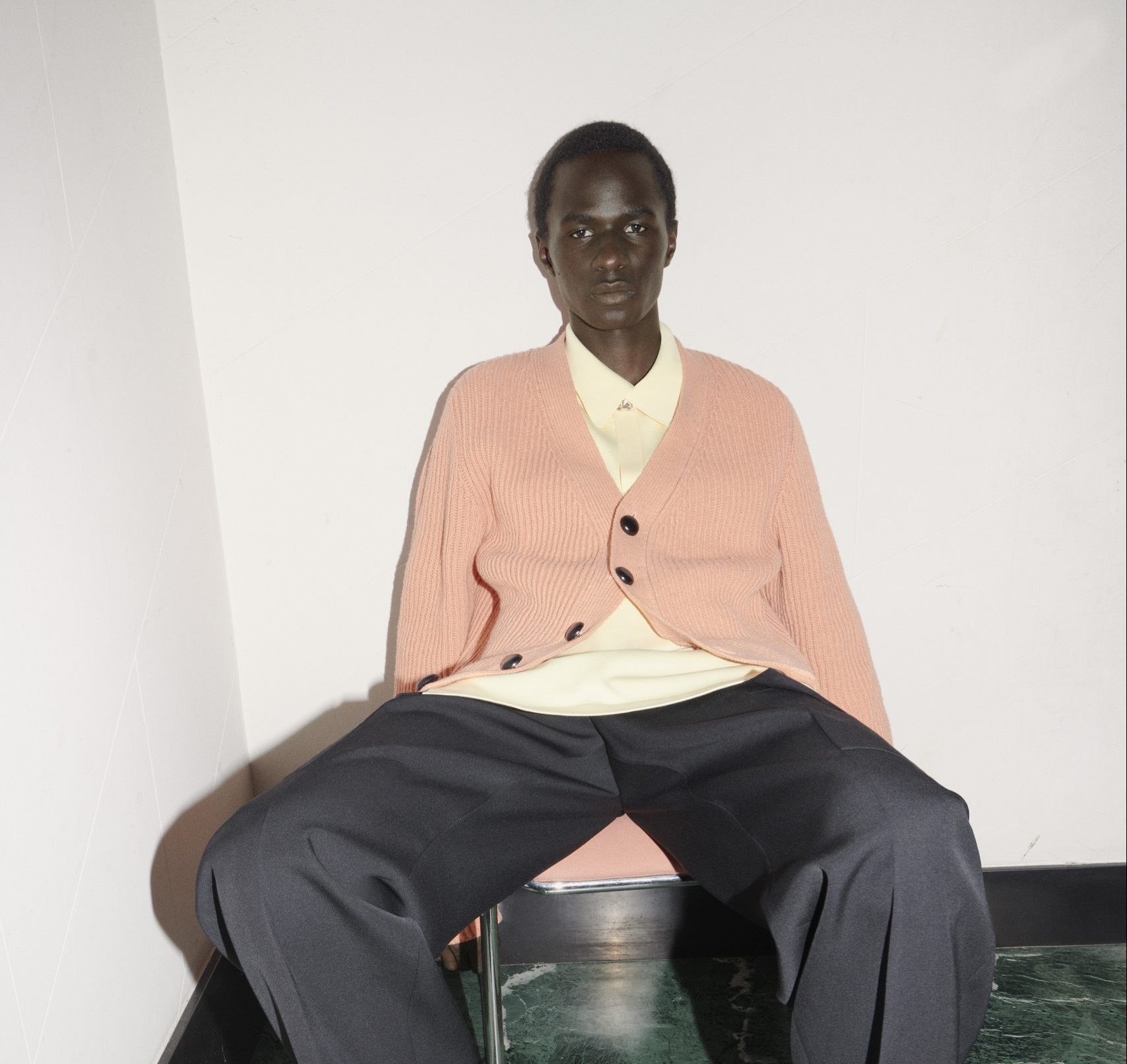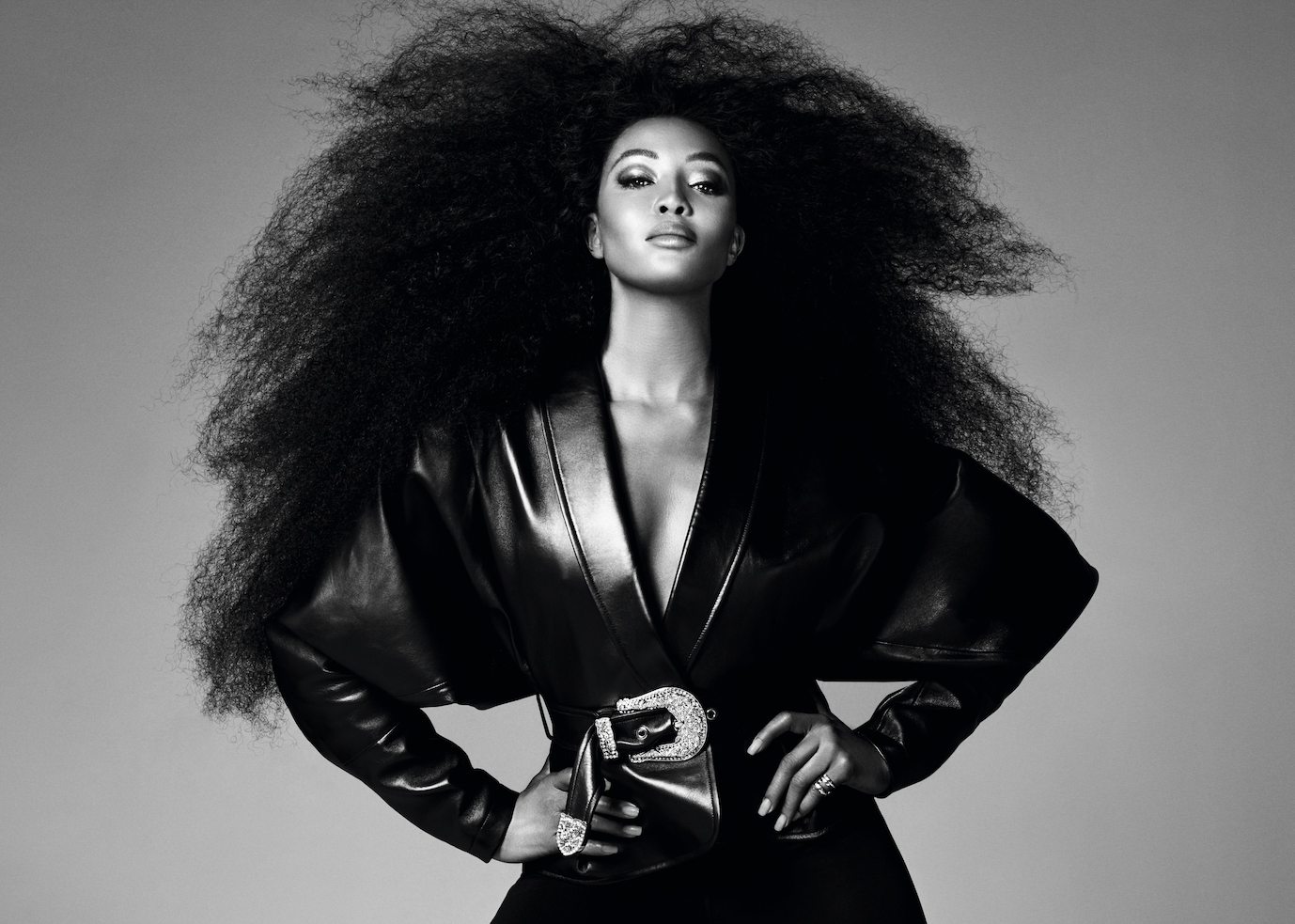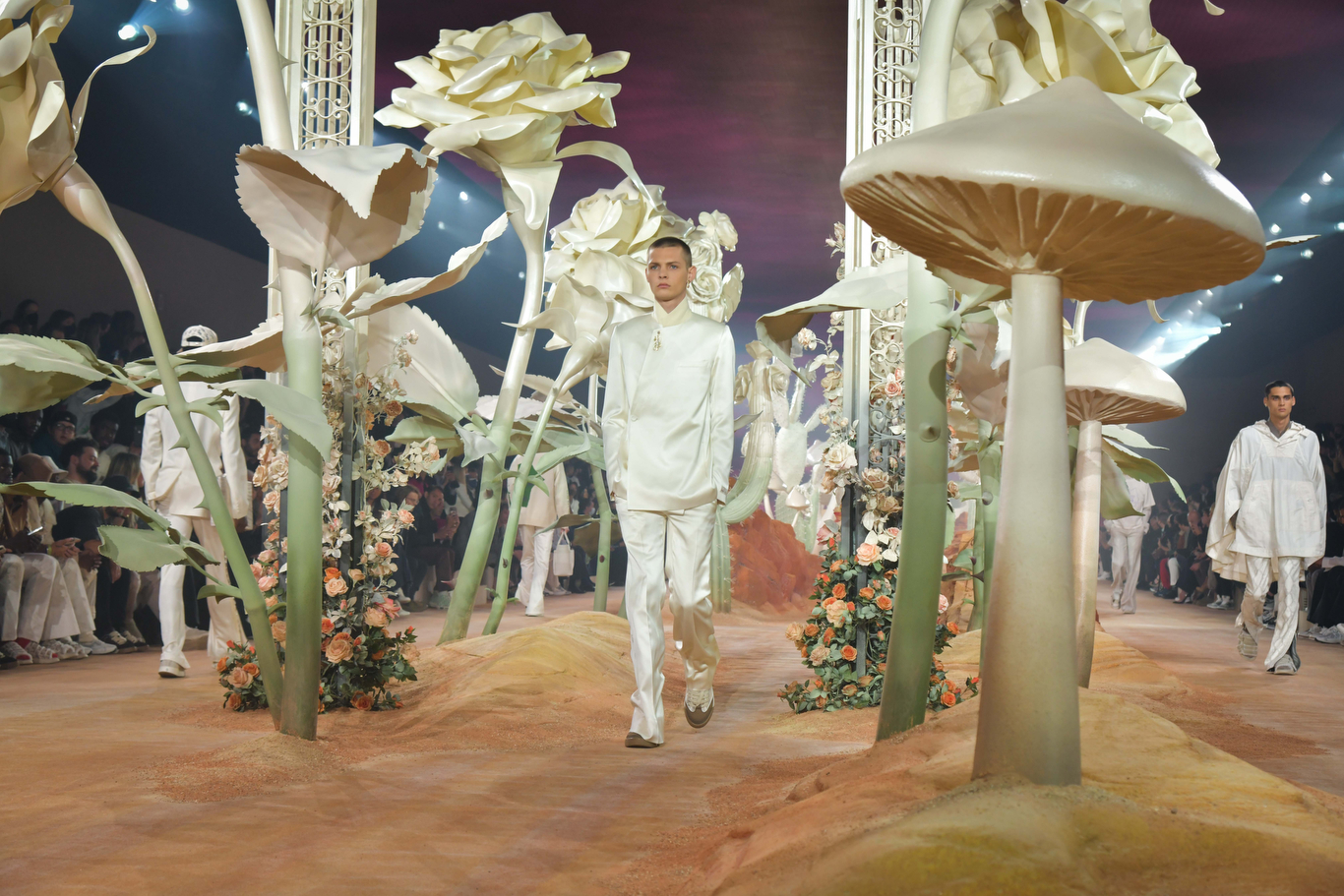
Eleven Things To Know – Paris Men’s Fashion Week
A curated look at menswear’s latest trends.
Related articles
Dior
So Travis Scott’s collaboration with Dior was a riot — literally. The French fashion house unveiled the collaboration on Friday in front of 500 guests at its first physical men’s runway show in 18 months. The event drew a large crowd outside, which surged forward and knocked over a security barrier when the singer left the venue, forcing him to retreat back inside — before reemerging to commune with his fans in an impromptu street mosh pit. Backstage after the show, the situation was equally chaotic, as photographers jostled for a shot of the rapper with Dior’s artistic director for men’s wear Kim Jones, who vainly pleaded for social distancing.
It was the first major celebrity fashion moment in Paris since the outbreak of the coronavirus pandemic, and one befitting Scott’s status as a pop cultural icon. “He’s a cultural phenomenon, and culture is something that the young generation want to associate with, especially when they’ve been away from everything,” Jones said. After three seasons of online shows, each with a different artist as guest collaborator, his decision to link up with a musician could not have come at a better time. “It gets people excited. Dior’s done particularly well in the last year. Everywhere you go, there’s a queue outside the store. We’ve been selling all sorts of things to all sorts of people, and I just want to continue to grow that message,” the designer explained.
It’s the first time Dior has designed a full collection with a musician, and Jones made sure the house’s codes were front and centre, making tailoring — and particularly his signature Oblique jacket — the backbone of the lineup, although flared pants added a ’70s twist to the look. Scott brought in further psychedelic influences, from the sun-bleached pastels and acid green of the colour palette, to the giant mushrooms and cacti dotting the desert-like set, which symbolized the performer’s home state of Texas and his creative collective Cactus Jack.
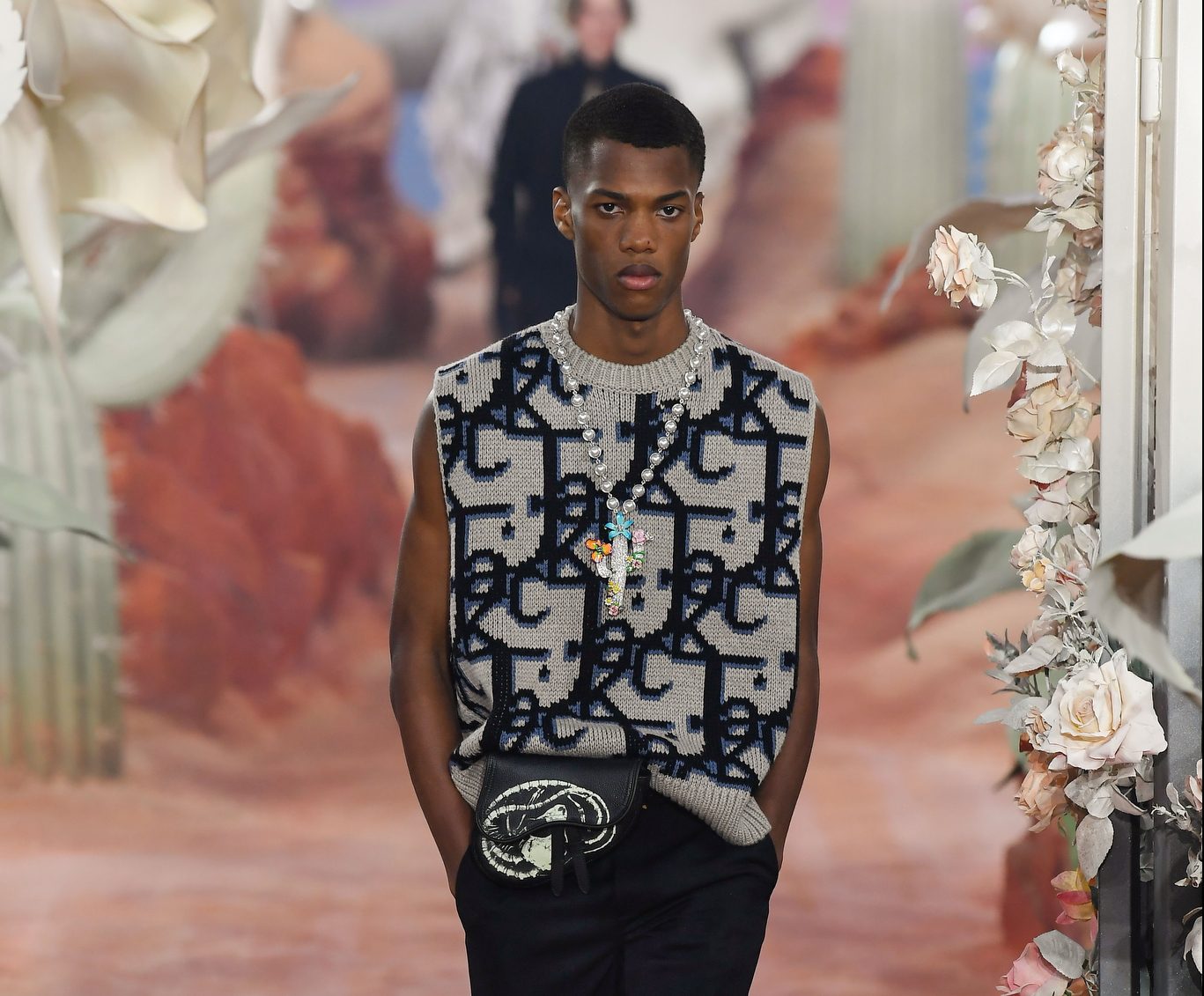
“The cactus is one of my enduring inspirational plants,” said Scott, adding that his birth name is Jacques and his mother calls him Baby Jack. “It’s a label and a movement, an idea and an inspiration that we try to instil and keep moving, trying to help the world with new design and inspirational experiences.” Naturally, he provided the throbbing show soundtrack, including a new track called “Lost Forever,” cowritten with James Blake and Westside Gunn.
Jones noted that Christian Dior visited Texas on his first trip to the U.S. in 1947. “We’ve basically done the reverse journey via Travis,” he remarked. Western-style touches included python prints, a dusty suede jacket and a double Saddle bag with a stirrup handle. Graphics ranged from Cactus Jack’s signature hand-drawn graphics to a new version of the Dior Oblique logo spelling out the word “Jack.” It turns out Bernard Arnault, head of Dior’s parent company LVMH Moët Hennessy Louis Vuitton, personally OK’d the irreverent take on one of his most valuable pieces of intellectual property. “I knew he’d love it or hate it, and he got it completely,” Jones said. “He likes to see energy and fun. He’s seen everything in the world. I always enjoy spending time with Mr. Arnault because of his eye. He knows exactly what he likes and he knows exactly what works — that’s why he’s Mr. Arnault.”
It’s easy to see why the luxury mogul would roll out the red carpet for Scott, who has collaborations with brands including Nike, Playstation, Epic Games and Dover Street Market under his belt. The musician’s collaboration with McDonald’s last year resulted in meat shortages and helped to drive up the fast food giant’s shares. Online chatter around the Cactus Jack Dior collection homed in on the new skate-inspired sneakers, which Dior is no doubt hoping will match the success of its Air Jordan trainers released last year. No matter what the commercial results, the amount of brand heat generated by Friday’s event was priceless. Jones will be tracking another barometer of success. “It’ll be interesting to see how many young kids you see wearing suits now after this, because he’s a big influence. I don’t like doing things for hype, I like doing things for exciting the consumer,” he said. – Joelle Diedrich.
Hermès
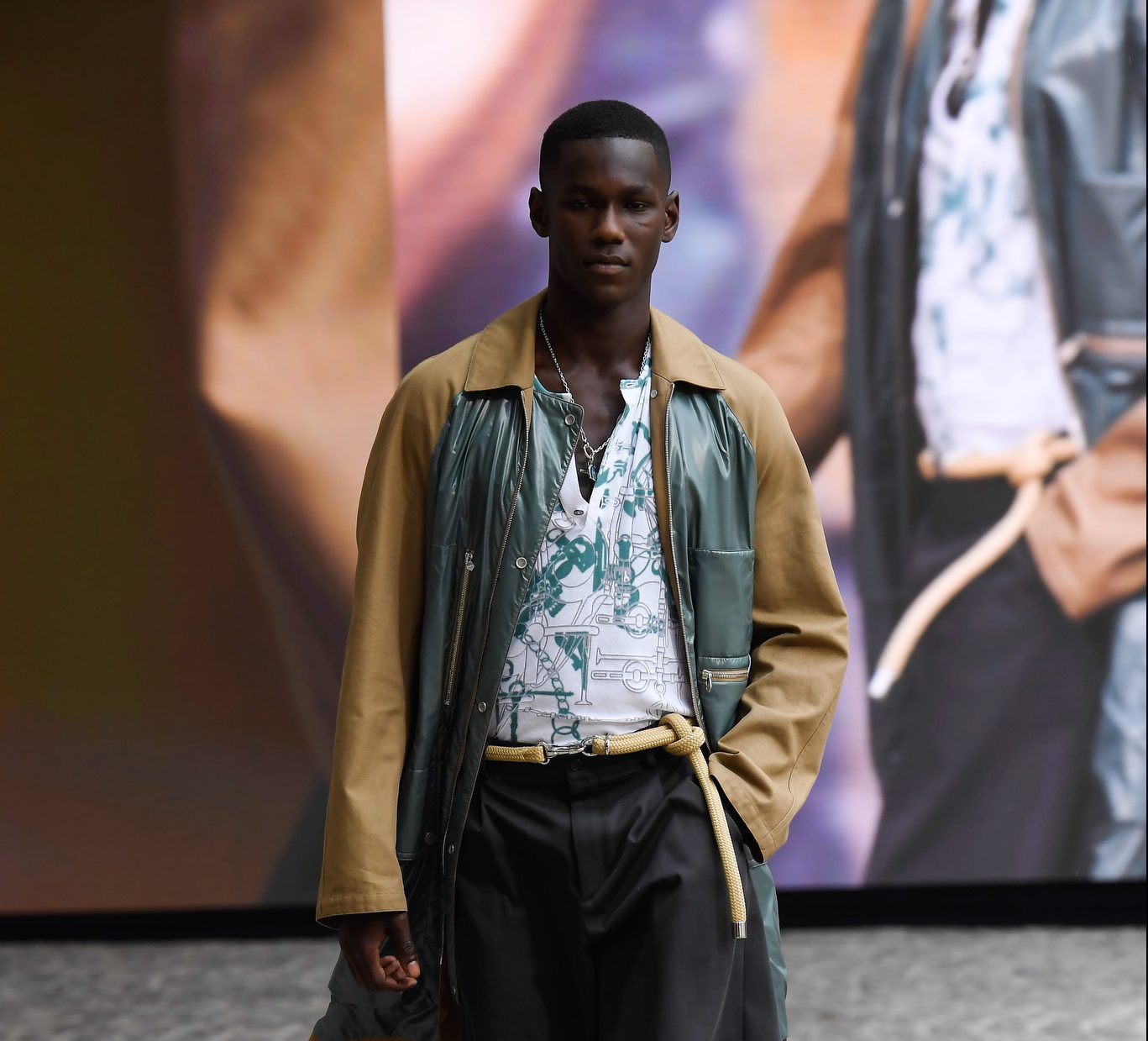
Véronique Nichanian delivered an upbeat collection for spring, defying the gloomy weather — and sprinkle of rain — with a lively offer for her first runway show since the onset of the pandemic. She continued to push forward with her hybrid, indoor-outdoor thrust, proposing hooded parkas, two-toned jackets with patches of technical fabrics and leather overshirts. In a burst of optimism, a bold, thickly knit sweater came in gradations of tangerine and pink, while a button-up cardigan faded from grey to a bright turquoise. “It aims to encourage people to get out and roam,” Nichanian said of the lineup, as quoted in the show notes.
As the fashion world rushes to meet consumers stepping back into society, many are betting on louder, hyped-up propositions — club themes and psychedelic motifs abound. But then there’s Nichanian, who is steadily building a fresh repertoire for younger classes of luxury consumers — a bit more discreet, for sure, but nonetheless interesting. The label’s playful side was relayed through the details, like the perforation delineating the house’s Quadriga horsehead motif on a shirt, zig-zag stitching — the kind you might see on a boat sail — running sideways on a windbreaker, and the zip-up blouson in a technical fabric, printed like a traditional silk scarf. In an understated nod to youth culture, the bottom of the Bolide bag was in the shape of a skateboard. A new silhouette emerged, too, drawing on cropped jackets and high-water trousers, worn with canvas high-top sneakers, successfully channelling the famous nonchalant French attitude. Accessories included belts made of rope or technical knits, with hook clasps and “H” buckles, sandals and suede goatskin ankle boots, as well as bags in military canvas. The house teamed for the third time with director Cyril Teste, who continued to bring fresh ideas to the evolving craft of fashion presentations.
The partnership has proven successful for capturing the mood, relaying the excitement of a show through a screen when in-person events were not possible, and this time, offering a view on details that would be lost in a traditional show, thanks to movie theatre-sized screens alongside the runway. The show was held outdoors in the courtyard of a favourite Hermès show venue, France’s Mobilier National building, home to the state-owned furniture.
Perched on boxy seats, the audience donned black rain capes by the label Rains. “Unforeseen events stimulate creativity,” Nichanian said. “I had to reinvent my approach to designing and presenting clothes.” Reinvention has indeed been a buzzword during this choppy period, and it’s clear the historic house approaches the concept with great care. But the role of experience feels equally relevant, especially when considering that Nichanian’s tenure stretches back to 1988, serving as a reminder that with disruption also comes the opportunity for the well versed to shine. — Mimosa Spencer
Louis Vuitton
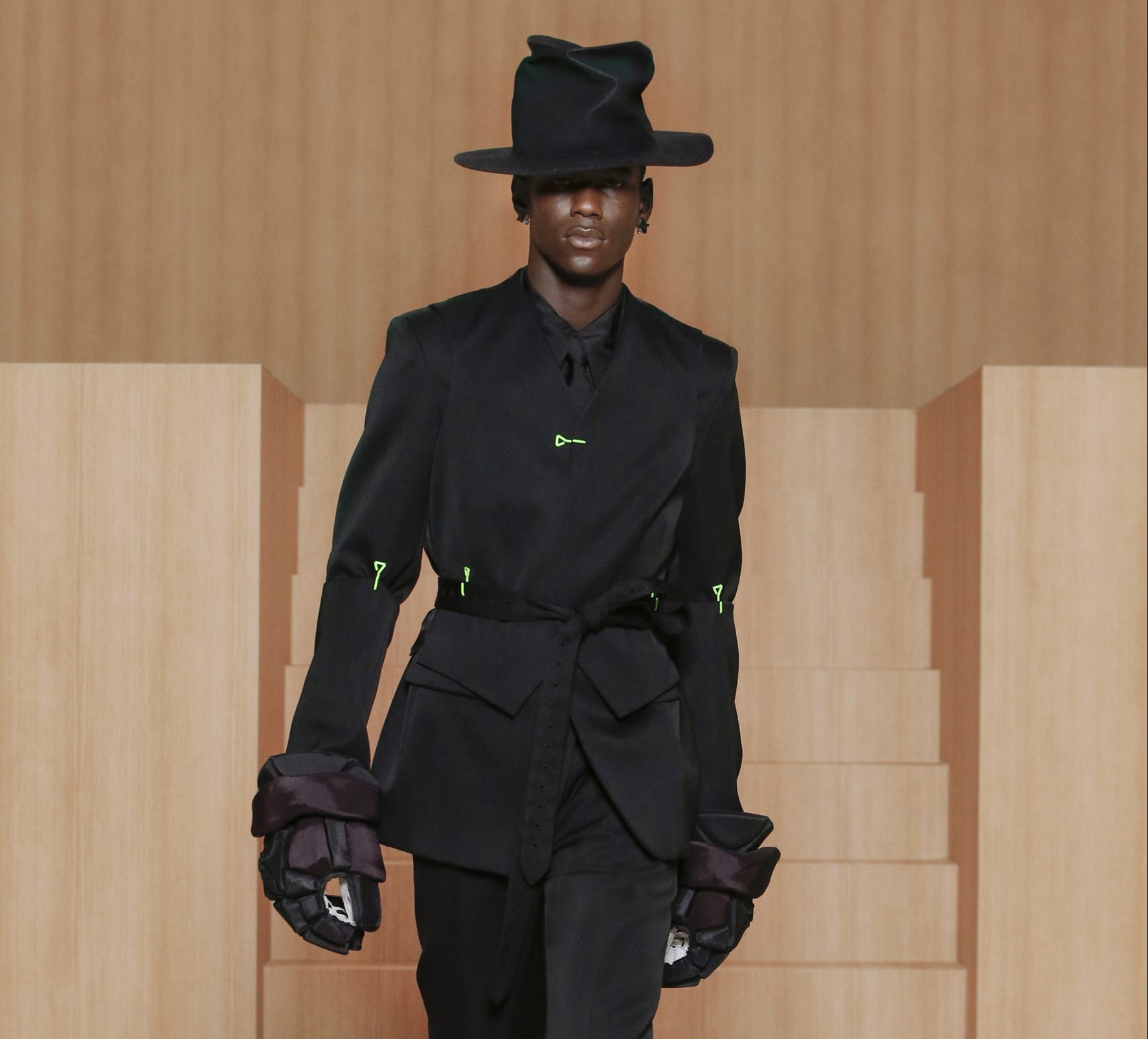
‘Tis the season of the mega-collaboration.
Just hours after Dior revealed it was teaming up with Travis Scott on its spring 2022 men’s collection, Louis Vuitton dropped another bombshell during Paris Fashion Week: The French luxury brand has partnered with Nike on new versions of its iconic Air Force 1 sneakers.
The shoes, which come in 21 colourways, were unveiled on Thursday as part of Virgil Abloh’s men’s collection for Vuitton, but additional details were scarce. Asked whether they would be made available for sale, the house merely said: “Stay tuned for more details.”
The launch marks a full-circle moment in hip-hop culture. Abloh, who has a highly successful collaboration with Nike through his Off-White label, was inspired by the cover of the 1988 album “It Takes Two” by Rob Base and DJ E-Z Rock. It shows E-Z Rock wearing a Nike Air Force 1 basketball trainer altered with a swoosh adorned in the Louis Vuitton monogram.
“The cover embodied the hip-hop community’s early practice of hacking together high fashion and sportswear, sidelining diverging brands with equal reverence. A cultural symbol in its own right, today the Nike Air Force 1 serves as an objet d’art emblematic of self-generated subcultural provenance,” Vuitton said in its collection notes.
Or as Outfitgrid founder Dennis Todisco commented on Instagram: “When the fake becomes real.”
For Abloh, the U.S.-born son of Ghanaian immigrants, it’s yet another chapter in a narrative that has seen him rise from outsider to kingmaker. He acknowledged as much in a short speech to his team, gathered in a cinema in Paris for the premiere of his collection film, titled “Amen Break” after a famous drum sample.
“Fashion can make you feel like things are impossible. We’re a part of a team that can make people feel a specific way. And through this body of work that we’re about to see on the screen, we deconstruct and dissolve and melt away this idea that fashion is elitist, or fashion is for only a select few,” he said.
Indeed, Abloh has blown open the gates of luxury to a whole new category of participant, from the kids who line up for his sneaker drops to the talent that takes part in his shows.
Musicians GZA, Goldie, Saul Williams, Lupe Fiasco and Shabaka Hutchings appear in the film alongside “Les Misérables” actor Issa Perica, in a storyline inspired by the classic Japanese kung fu film “Lone Wolf and Cub.” Chess is a sub-plot, inspired by the cover of GZA’s seminal album “Liquid Swords,” as well as Vuitton’s signature Damier motif.
In fashion terms, the theme translated into a plethora of check motifs, on items ranging from luxed-up track suits to tailored suit jackets paired with floor-length skirts, in a nod to traditional garments ranging from kilts to kendo uniforms. Checkered bodysuits served as an underpinning for a fuchsia suit, a silver foil jacket and pants, and sober black outfits inspired by martial arts garb.
The central idea was a confrontation between tailoring and trackpants, which materialized into a human chess game — though there was ultimately no winner. “I’m not choosing between one or the other. My signature is both,” Abloh said, noting that the logo of the film contains a yin-yang emblem. “That symbol fits perfectly in my canon.”
Hence the leap between his new-gen suits — think short, belted jacket and pooling pants — and the raver elements in the collection, including airbrushed monogram-embossed leather jackets, and an outfit pieced together from rainbow-coloured flyers printed on leather, featuring the logo of Goldie’s record label Metalheadz.
Abloh said he wasn’t playing along traditional gender lines either. “We have straight-up A-line skirts. It’s liberating in 2021,” he said, pointing to a black-and-white rain jacket worn over a hoop skirt. The designer considers it as the natural evolution of a year that has seen social issues from Black Lives Matter to trans rights take centre stage.
“The next thing in fashion isn’t in fashion. It’s in people, it’s in the atmosphere, it’s in the streets, it’s in the socio-political,” he said. “Decision, gender, diversity: those aren’t even hot topics. That’s top line. That’s already been established. Now, it’s developing men’s wear into showing the freedom that can be.”
Now on his seventh collection for the house, Abloh feels increasingly legitimate in delivering his point of view. “I’m older, so I don’t feel the fear of being young and trying to stake a claim or aim high,” he said. Yet the striver in him is never far below the surface: by bringing the bootleg back to the source, he’s scored yet another win for the culture. — Joelle Diedrich.
Loewe

Growing up in Northern Ireland, Jonathan Anderson remembers going out to the clubs on Friday night, which involved “lots of aftershave” and experimenting with different kinds of fashions. He channelled that anything-goes, hedonistic spirit into his spring men’s collection for Loewe, which goes from handsome tailored coats in the Spanish house’s Anagram logo or glossy cactus leather to what he described as “full disco ball.” Cue the show video, which depicts a young man in a tinsel-fringed tank and shorts dancing with abandon in a nightclub in Marseille, laser beams slicing the air. Other revellers showed up in sequined, zebra-motif shorts and tops, or neon knits layered up like glow-stick bracelets. “It’s about dressing outside of your comfort zone, or dressing for imaginary or real events,” Anderson explained in a Zoom call. “It’s about losing yourself in a crowd.”
In addition to the video, with voiceover musings from Anderson, Loewe published two sumptuous hardcover books: one featuring the hoodlum paintings and grimy, violence-tinged photos of German artist Florian Krewer; the other photos by David Sims of street-cast characters hanging around a basketball court, or playing with pink bubble wrap in a studio. Also included in the designer’s latest “collection in a box” were art posters, luminescent bedroom ceiling stars and a snap bracelet. Despite that avalanche of content, some of it disquieting, and Anderson’s deep thoughts about our nearly post-COVID-19 world, what came across in the collection was spontaneity and the rush of fashion experimentation.
Like a teenage Anderson prepping for a big night out, one can imagine a daring Loewe customer tickled to try out a leather parka with portholes at the knee; a tiered top of knotted and draped satin, or a ribbed cotton tank and matching shorts in a beach-y print. One of the most striking — and bonkers — garments in the collection is a lean Crombie coat with a convex shield of hammered metal sewn into the back. Anderson loves that it “distorts the silhouette” while at the same time reminding him of the funhouse mirrors at a local carnival. Boys, they wanna have fun, too. — Miles Socha
Jil Sander
“It’s about the person, rather than the uniform,” said Luke Meier, discussing the men’s spring 2022 collection he codesigned with his wife Lucie. It was presented as part of Paris Men’s Fashion Week with a video filmed at a shabby, dated Milanese hotel.
Luke Meier, who is Canadian, looked back at his years in New York City when he was designing for Supreme. “When I moved there, I discovered that guys had the best kind of style; they were mixing and matching things, experimenting with garments in their wardrobe, in a way [that] felt sophisticated and effortless,” he explained during a meeting at the Jil Sander showroom in Milan. The collection felt more relaxed and in sync with the current times than ever. The designers experimented with colours, shapes and patterns in a way that felt chic, but with humour and an effortless cool. Sartorial influences merged with utilitarian and streetwear influences, while more eccentric touches included silk tops with a fur-like look and jewellery details.
The lineup included suits in pastel tones cut in precise, yet relaxed silhouettes; a cheetah-printed furry vest was layered under a hooded lightweight coat; ribbed cardigans with leather-covered buttons were paired with polo shirts, while colour-blocked vests with a tactile feel came off as arty. Vintage graphics appearing on the windows of local delis in New York were introduced in the collection through the patches peppering baggy pants, the artisanal intarsia and embroideries of knitted pieces, as well as via allover prints on flight suits. With this spring effort, Lucie and Luke Meier unveiled a new side of their multifaceted creativity, one light-heartened and young. — Alessandra Turra
Paul Smith
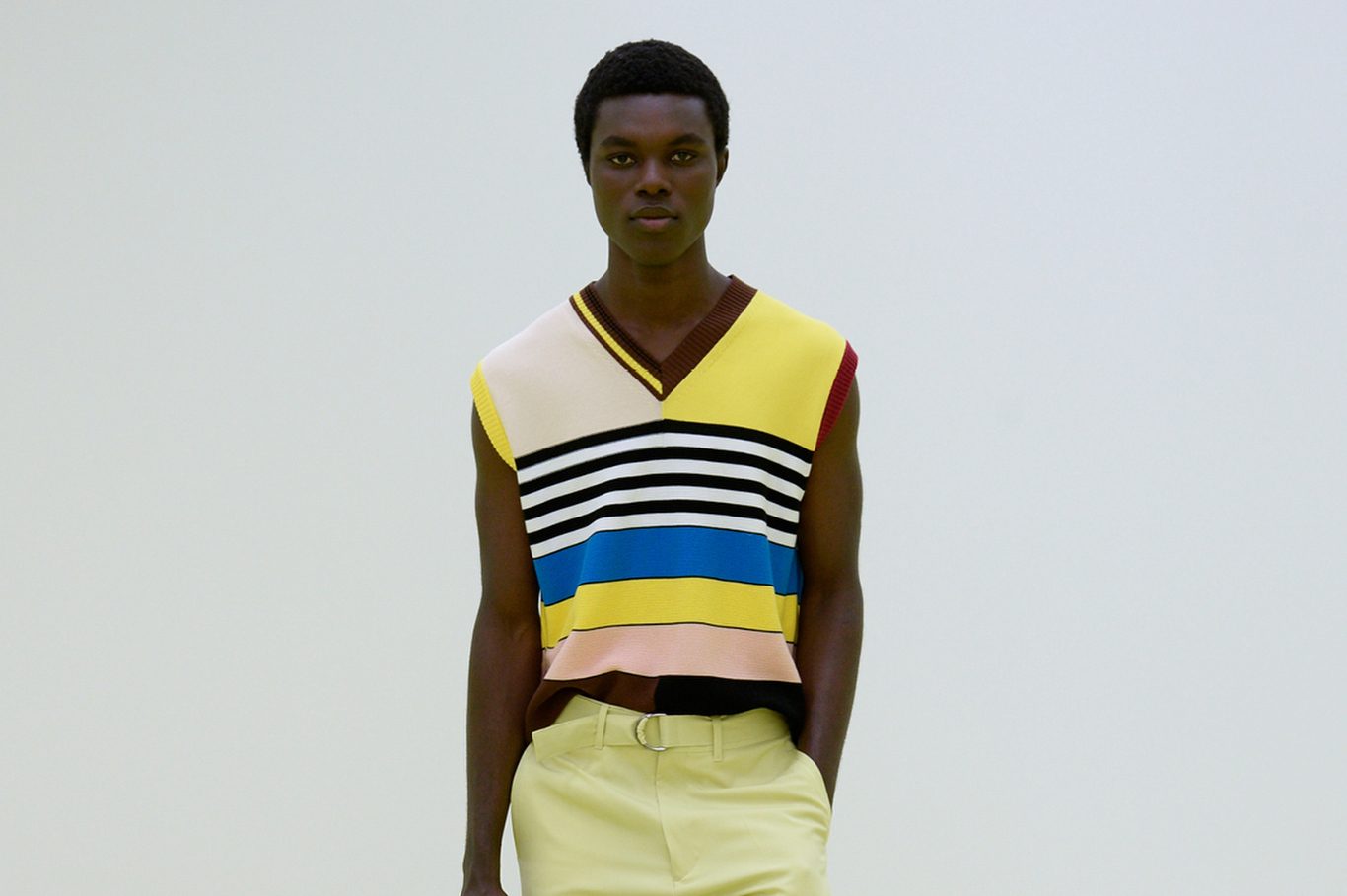
Don’t read too much into the “outdoor exploration” theme Paul Smith assigned to his sprightly spring men’s wear collection. “It’s not about hunting, shooting and fishing. It’s more about, ‘At last we’re out!’” he said, expressing that universal yearning for fresh air and open spaces after extended periods of sheltering in place. Tourists of yore — including the era of leisure suits — came to mind viewing the shirt jackets, blousons and safari styles matched to Bermudas or pleated pants, and accessorized with sun hats and cross-body bags.
In fact, Smith was just showing that a suit can now be composed of many different elements. He coined the term “new working wardrobe” for tailored items done in a range of fine Italian fabrics, colour unifying the top and bottom pieces. And my, what colours! Smith has a vacation home in Lucca, Italy, and he borrowed the shades of Tuscan terracotta, the Mediterranean sky and those dramatic summer sunsets, giving his lineup a summery spirit. Bold sunflower prints looked great on camp shirts.
When Smith started out in men’s wear, stripes for men came in navy and white, burgundy and white and not much else. He’s pioneered multicoloured stripes and they looked terrific here as a snug scuba top or a slouchy sweater with the ease of a sweatshirt. The designer also employed stripes from vintage tents for a collaboration on nylon bags with Japanese luggage-maker Porter. Smith’s creative video had models whisking across an indoor runway set consisting of an undulating ceiling and a speckled floor resembling a vintage Formica kitchen table. But do take these smart and cheerful clothes out for a stroll. — Miles Socha
Casablanca
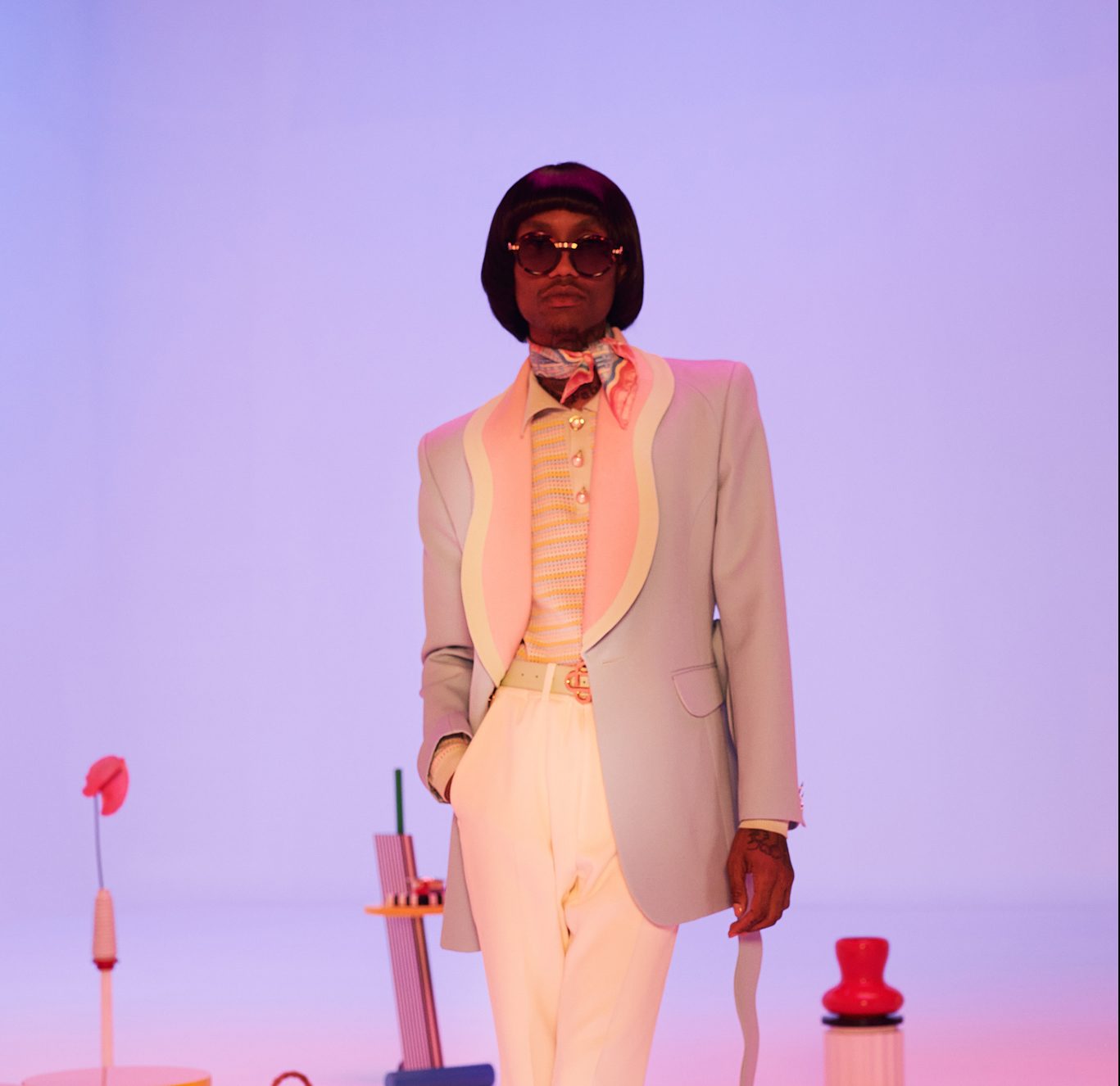
It’s been a tough year for globetrotters like Charaf Tajer. The Casablanca designer dedicated his spring collection to a friend in Japan, a country he’s visited 26 times by his count. “Every time I go, it’s more and more impressive to me. Japan for me is almost like school; I learn so much,” he raved. “The way they execute things, the way they are passionate about everything. So I wanted to pay homage to this place that I miss and I love so much.” He titled the coed collection “Masao San” after his old pal, a waiter with a unique sense of style. “He’s really a phenomenal person,” Tajer explained. “He inspired me on so many levels.” The film alternated between the graphic aesthetic of ‘90s Japanese consumer electronics ads, and elements of ‘80s Memphis design set against a pastel backdrop. “I’m having a baby in September and I think that inspired me indirectly. We were designing and we noticed that everything came out in a baby palette,” Tajer said. The combination of the brand’s signature colour gradients with Memphisstyle wavy lines made for a surefire dopamine boost.
There’s something naively enthusiastic about Tajer’s embrace of different cultures that’s reflected in his trademark souvenir jackets, which this season were embroidered with shell motifs or a rendering of Mount Fuji. From there, he bounced off in several directions.
The designer offered suit jackets with squiggly lapels, and a fresh take on the Casablanca monogram in a zig-zag pattern — a teaser for his upcoming collaboration with table tennis gear-maker Butterfly. To celebrate the reveal, he hosted a cocktail at the Ritz hotel, where a pingpong table was set up near a grand piano in a reception room.
In the garden, Alton Mason, modelling a short-sleeved zippered jacket and white pants, mingled with guests including Ella Emhoff and her boyfriend Sam Hine, and “Emily in Paris” stars Ashley Park and Samuel Arnold. Tajer had initially planned to stage a physical runway show, but said too many guests were still unable to travel to France. “I prefer to come back when it’s time to do the shows in the right way,” he said. No doubt, his colourful vision will be even more of a tonic in 3D. — Joelle Diderich
Burberry
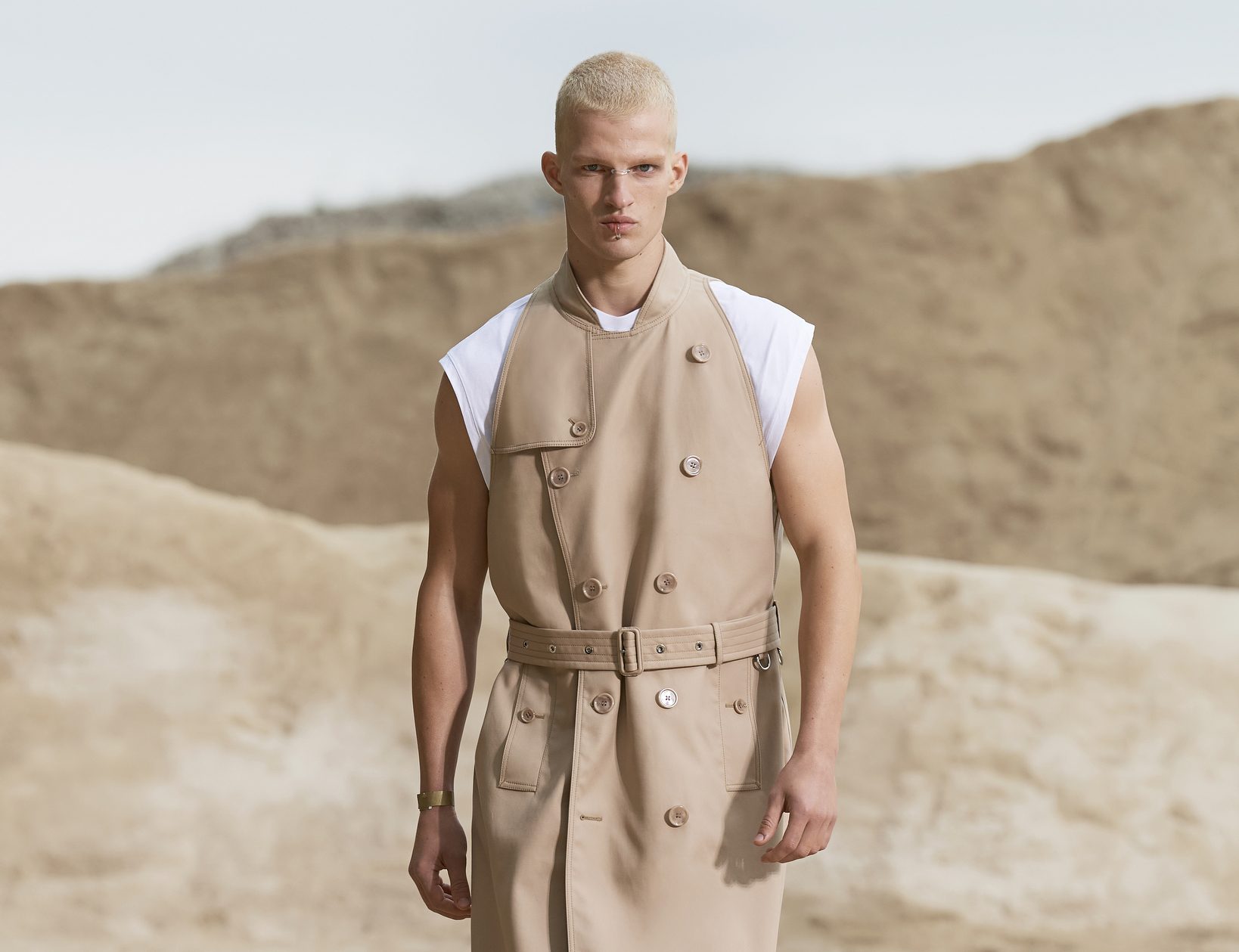
Riccardo Tisci is feeling the heat — of summer, dancing in the desert and outdoor raves. His collection, filled with spare shapes, sleeveless silhouettes and lots of graphic patterns, was a tribute to the outdoors, post-lockdown freedom and a new generation of customers that wants to wear Burberry in the heat — as well as in the cold and rain.
Tisci said he’s been looking at who’s buying from the brand, and said the new, younger customer is spending on sporty, featherlight hoodie jackets, sneakers, jersey pieces and swimwear. “They want summer from Burberry,” he said in an interview. “So it’s a playful wardrobe — deconstructed classics for summer.”
He lopped the sleeves off trenches, tops and hoodies; did away with collars and lightened up tailored pieces to great effect. Female models wore itsy bitsy bathing suits — and they were certainly well-dressed for the weather on set. The show was shot against a background reminiscent of “Mad Max” films at Royal Victoria Dock in East London. There were mountains, acres of sand and a little zone off to the side where Burberry-clad ravers moved to an electronic soundtrack from the English music project Shpongle.
Boxy tops — a personal favourite of Tisci’s — were made for moving, dancing and keeping cool. They were sleeveless, too, and some had geometric patterns at the front. There was lots of leather — harness tops and sleeveless bomber jackets with rib-knit trims and studded straps — although they might begin to feel a little sweaty in the desert sun. In addition to the chic, stringy bathing suits, Tisci’s women wore slip dresses and a sequin-covered trench that glittered oasis-like against the sand.
It is clear that three national lockdowns, and ongoing social and travel restrictions in the U.K., have been getting under Tisci’s skin. “To be in a big open space! To be able to scream! I think a lot of people — and especially teenagers and people in their 20s — are all feeling the same way,” he said. It’s no wonder he called the show “Universal Passport.” The Brits — no matter how old or young — are desperate to get the heck out, socialize, travel abroad — and shout. — Samantha Conti
GmbH
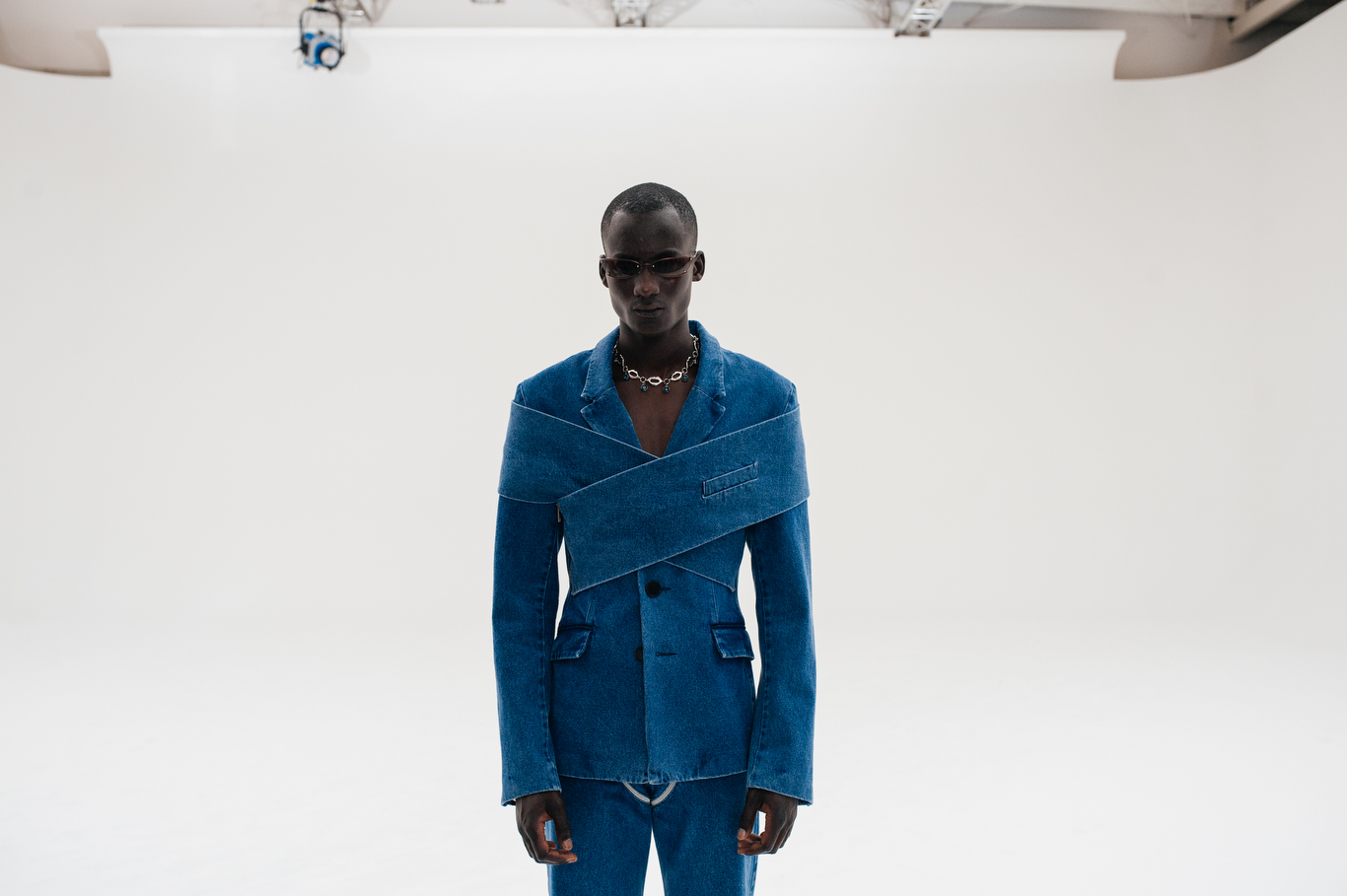
Diversity has always been at the root of the GmbH label, with founders Benjamin Huseby and Serhat Isik mining their multicultural backgrounds with strongly autobiographical collections. This season, the duo turned the tables with a lineup that riffed on bourgeois tropes and WASP culture. “We wanted to shift the conversation. Instead of always focusing on our own Blackness or brown-ness — being the ‘other’ — we wanted to talk about whiteness,” Huseby explained. “We definitely wanted to create a conversation that might make some people uncomfortable.” The collection, titled “White Noise,” is a wry comment on the ruling class, viewing yuppie staples like jodhpurs, polo shirts and riding boots through a queer lens. Varsity vests were ruched to expose the midriff, while Western shirts came tied at the waist to show off silver belly chains. A striped dress shirt, meanwhile, was inset with panels of corset lacing. The designers reprised the shawl constructions they introduced last season, but gave them a lighter spin in fabrics like denim, or baby pink and blue fake fur, paired with shredded jeans. They were inspired by scenes in the documentary “Paris Is Burning,” showing Black and Latino ballroom dancers competing in bougie Town and Country outfits, as well as the way music stars in the ‘90s were appropriating and subverting white culture.
“Fashion is a kind of drag, so no matter what you wear, you’re dressing up for a role, even if you’re subconscious about it,” Huseby said. In contrast with most brands’ reluctance to comment on the Israeli-Palestinian conflict, GmbH has collaborated with Palestinian fashion label Trashy Clothing on a halter top that reads: “Free Palestine.” Proceeds will benefit charities including Al Qaws, the oldest official Palestinian LGBTQ organization. Despite the risk of backlash, Isik, a German of Turkish descent, believes fashion needs to address political issues.
“Ten years ago, pre-identity age, my graduate collection was about Islamophobia. The collection was called I Don’t Have Any Weapons, and I was barely allowed to defend my thesis at the university. And now we’re here, and we are in the positions that we are,” he said. “We have to continue being brave and talking about these things.” Huseby and Isik were recently named creative directors of Italian brand Trussardi, which touted their “socially engaged perspective.” This collection proved they won’t be toning it down to court mainstream acceptance. — Joelle Diderich
Officine Générale
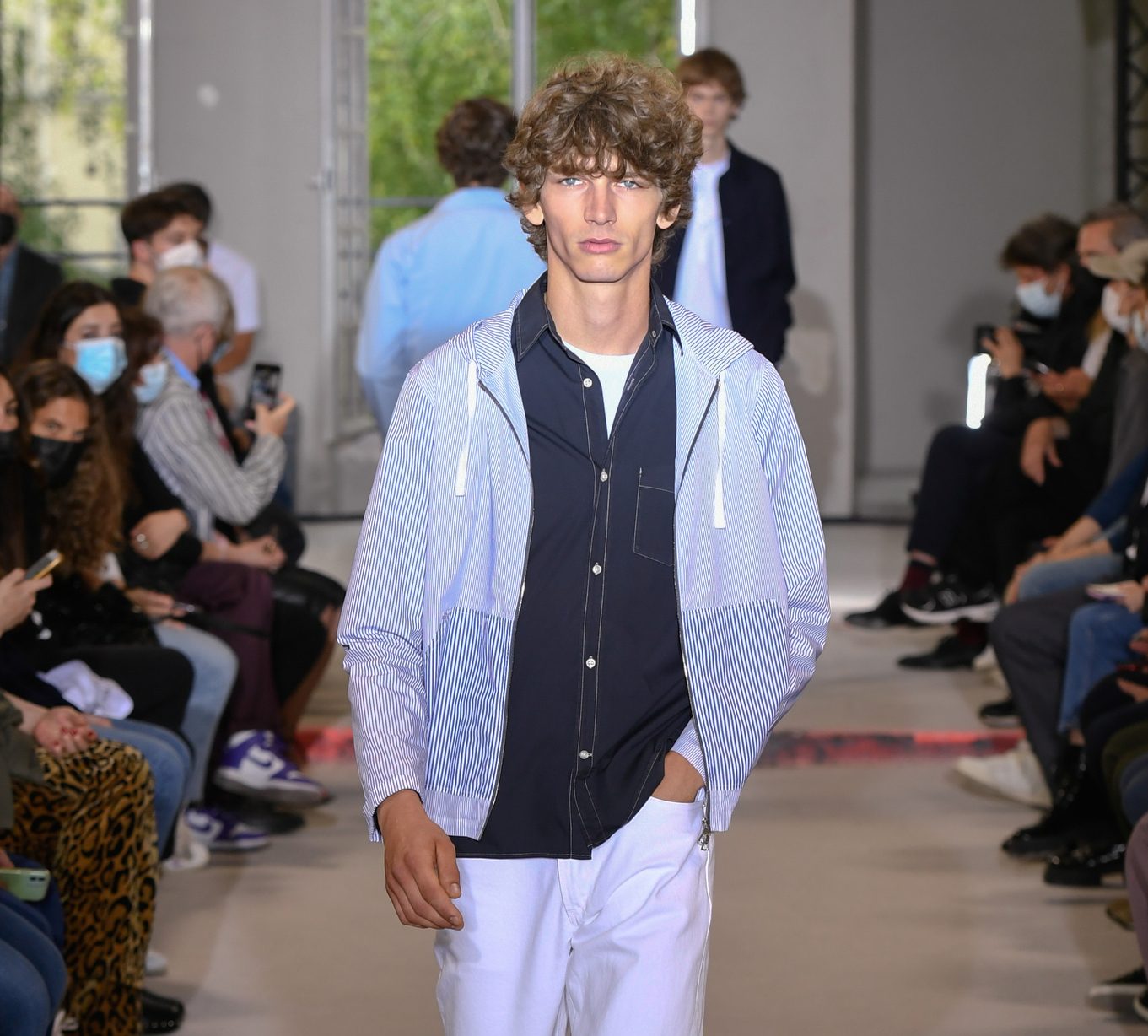
Celebrating the return of Parisians to the streets of their beloved capital, Pierre Mahéo took to the runway with a coed lineup that channelled the city’s nonchalant elegance and its current festive mood. The venue was a spacious historic building in the heart of the Marais district, hollowed out for renovations, with space to mingle — and reunite. “I wanted to get back to a fashion show without any further delay,” the designer wrote in a note to guests. He went on to explain how the prolonged period grounded at home had allowed for deep exploration of his Parisian roots. This yielded a lineup of suits and trouser-jacket combinations for spring, with plenty of options for anyone interested in riding the shorts-for-the-office trend. Plying monochromic looks, Mahéo offered them in navy, olive green, greys, ivory and an eye-catching lavender. He also wove in an extra soft, recycled denim, zip-up shirts and hoodies that edged over to the realm of outerwear, as well as leather bomber jackets, some tie-dye and a few dresses — one printed with paisleys. Mahéo has built his label on a contemporary approach to tailoring, working in extra ease without compromising the refinement intended by such silhouettes. Mastering the slouchy trouser, he worked in straighter cuts from the knee down this season, and included baggy, skater-style pants in a lightweight wool for summer. “Our pants business has been on fire for the past year and a half,” he said after the show, still breathless from the emotion of the first runway presentation in 16 months. He mentioned he’s off to New York shortly. The label plans to open a store in the city, kicking off an expansion drive backed by new investors. It might be just in time for the big migration back to work. For anyone feeling apprehensive about the return to office life, Mahéo’s got some good ideas about what our uniform should be. Dress like a Parisian. — Mimosa Spencer
Dunhill
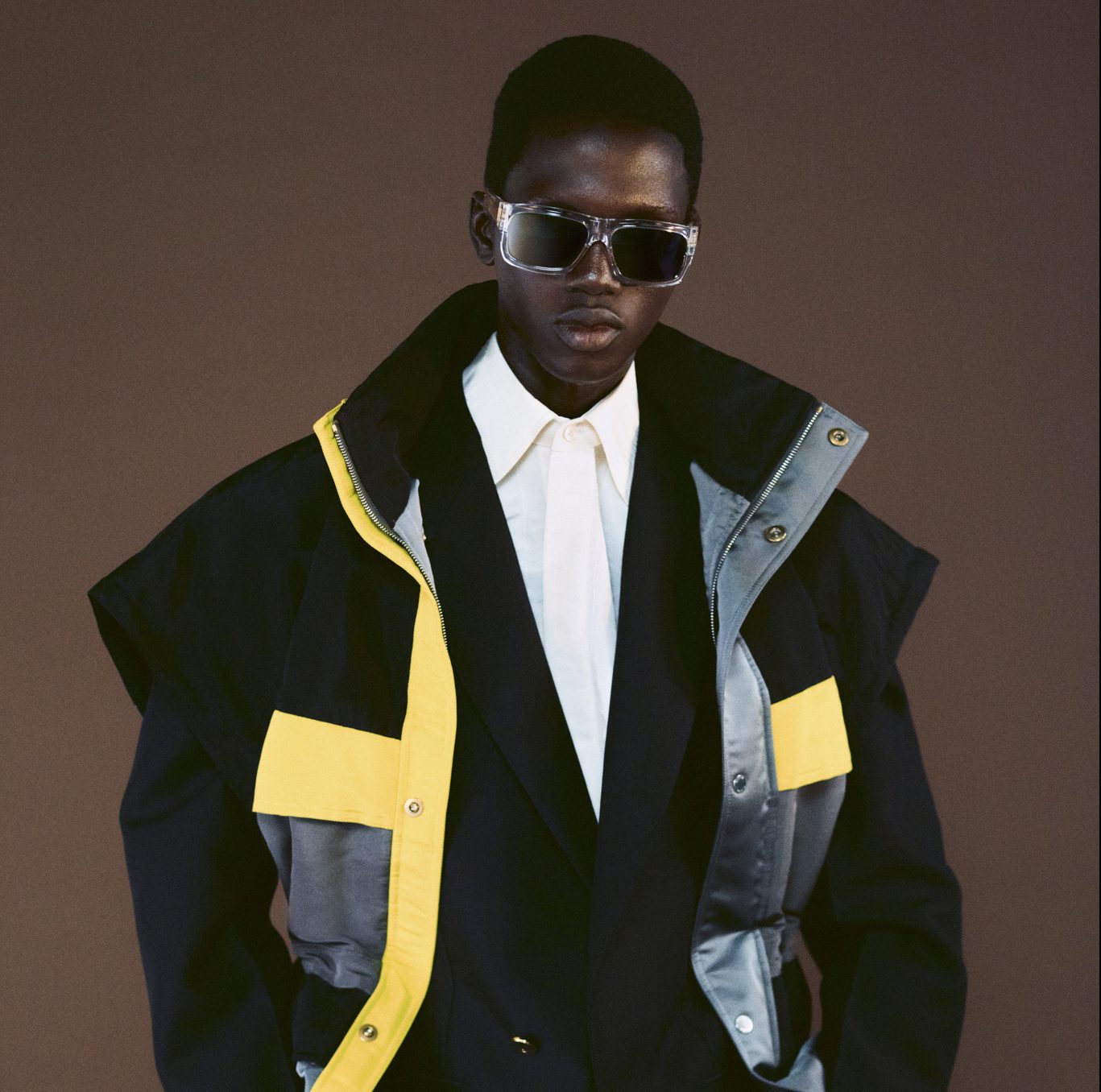
Mark Weston, who took a few cues from Coco Chanel, swapped nylon for silk faille and worked a playful colour palette inspired by the Polaroids of artist Ellen Carey, described this collection as a marriage of “extravagance — and practicality.” He was spot on, but he forgot to add one word: fun. This latest outing had all the whimsy and joy that Weston has quietly been stitching into his collections for the brand, which until just a few years ago was best known for its traditional tailored suits, tuxedos and luxe leather accessories, made for boardrooms, country clubs and corner offices.
Not any more: Weston may have a reverence for Dunhill’s past as a posh tailor, but he’s also been eager to dress a new clientele for lives that have nothing to do with mahogany desks and black tie fundraisers. His looser shapes, zingy colour palette (see the striped Dr. Who scarf from the fall 2021 collection) and nonchalant chic have been attracting customers from all sorts of orbits, including Kanye West, while in China, female celebrities like Chris Lee, Ni Ni and Song Zu’er have been wearing the men’s styles. Weston seemed to be having even more fun with the latest collection, making baseball caps — in pink, no less — out of silk faille fabric; roomy cardigans with shiny buttons that would have made Coco smile, or even fattening up seersucker stripes for a jacket that looked as if it were made from thick crinkly ribbons. There was a practical, utility side, too, in the form of modular parkas with zips and hi-viz pops of colour; the (now signature) split hem trousers done in nylon; electric bright cummerbunds (a nod to Dunhill’s tuxedo credentials) that doubled as crossbody bags, and — of course — a lineup of lovely tailored suits. Ellen Carey’s colorful psychedelic Polariod smears — made by pulling apart the photo papers — provided inspiration for prints on raw-edged silk tops, and for an upbeat palette of pastels and jewel tones designed for a good time, although not in the board room. — Samantha Conti
Subscribe to the Newsletter
Recommended for you
Ode to Oasi
Ermenegildo Zegna wrote the book on dapper Italian style. Now, a new coffee-table tome pays homage to its greatest creation—one that, hopefully, will endure long after the brand is gone.
By Brad Nash
June 25, 2024
Everybody Loves Naomi
Fashion fans adore her. And so do we. Lucky, then, that a new exhibition is paying homage to the undisputed queen of the catwalk.
By Joseph Tenni
June 22, 2024
You may also like.
By Josh Bozin
24/07/2024
You may also like.
5 Lounge Chairs That Add Chic Seating to Your Space
Daybeds, the most relaxed of seating solutions, offer a surprising amount of utility.
Chaise longue, daybed, recamier, duchesse brisée—elongated furniture designed for relaxing has a roster of fancy names. While the French royal court of Louis XIV brought such pieces to prominence in fashionable European homes, the general idea has been around far longer: The Egyptian pharaohs were big fans, while daybeds from China’s Ming dynasty spurred all those Hollywood Regency fretwork pieces that still populate Palm Beach living rooms. Even Mies van der Rohe, one of design’s modernist icons, got into the lounge game with his Barcelona couch, a study of line and form that holds up today.
But don’t get caught up in who invented them, or what to call them. Instead, consider their versatility: Backless models are ideal in front of large expanses of glass (imagine lazing on one with an ocean view) or at the foot of a bed, while more structured pieces can transform any corner into a cozy reading nook. Daybeds may be inextricably linked to relaxation, but from a design perspective, they put in serious work.

Emmy, Egg Collective
In designing the Emmy chaise, the Egg Collective trio of Stephanie Beamer, Crystal Ellis and Hillary Petrie, who met as students at Washington University in St. Louis, aimed for versatility. Indeed, the tailored chaise looks equally at home in a glass skyscraper as it does in a turn-of-the-century town house. Combining the elegance of a smooth, solid oak or walnut frame with the comfort of bolsters and cushioned upholstery or leather, it works just as well against a wall or at the heart of a room. From around $7,015; Eggcollective.com
 Plum, Michael Robbins
Plum, Michael Robbins
Woodworker Michael Robbins is the quintessential artisan from New York State’s Hudson Valley in that both his materials and methods pay homage to the area. In fact, he describes his style as “honest, playful, elegant and reflective of the aesthetic of the Hudson Valley surroundings”. Robbins crafts his furniture by hand but allows the wood he uses to help guide the look of a piece. (The studio offers eight standard finishes.) The Plum daybed, brought to life at Robbins’s workshop, exhibits his signature modern rusticity injected with a hint of whimsy thanks to the simplicity of its geometric forms. Around $4,275; MichaelRobbins.com

Kimani, Reda Amalou Design
French architect and designer Reda Amalou acknowledges the challenge of creating standout seating given the number of iconic 20th-century examples already in existence. Still, he persists—and prevails. The Kimani, a bent slash of a daybed in a limited edition of eight pieces, makes a forceful statement. Its leather cushion features a rolled headrest and rhythmic channel stitching reminiscent of that found on the seats of ’70s cars; visually, these elements anchor the slender silhouette atop a patinated bronze base with a sure-handed single line. The result: a seamless contour for the body. Around $33,530; RedaAmalou
Dune, Workshop/APD
From a firm known for crafting subtle but luxurious architecture and interiors, Workshop/APD’s debut furniture collection is on point. Among its offerings is the leather-wrapped Dune daybed. With classical and Art Deco influences, its cylindrical bolsters are a tactile celebration, and the peek of the curved satin-brass base makes for a sensual surprise. Associate principal Andrew Kline notes that the daybed adeptly bridges two seating areas in a roomy living space or can sit, bench-style, at the foot of a bed. From $13,040; Workshop/ APD
Sherazade, Edra
Designed by Francesco Binfaré, this sculptural, minimalist daybed—inspired by the rugs used by Eastern civilizations—allows for complete relaxation. Strength combined with comfort is the name of the game here. The Sherazade’s structure is made from light but sturdy honeycomb wood, while next-gen Gellyfoam and synthetic wadding aid repose. True to Edra’s amorphous design codes, it can switch configurations depending on the user’s mood or needs; for example, the accompanying extra pillows—one rectangular and one cylinder shaped— interchange to become armrests or backrests. From $32,900; Edra
You may also like.
By Josh Bozin
24/07/2024
22/07/2024
Watches & Wonders 2024 Showcase: Hermès
We head to Geneva for the Watches & Wonders exhibition; a week-long horological blockbuster featuring the hottest new drops, and no shortage of hype.
With Watches & Wonders 2024 well and truly behind us, we review some of the novelties Hermès presented at this year’s event.
—
HERMÈS

Moving away from the block colours and sporty aesthetic that has defined Hermès watches in recent years, the biggest news from the French luxury goods company at Watches & Wonders came with the unveiling of its newest collection, the Hermès Cut.
It flaunts a round bezel, but the case middle is nearer to a tonneau shape—a relatively simple design that, despite attracting flak from some watch aficionados, works. While marketed as a “women’s watch”, the Cut has universal appeal thanks to its elegant package and proportions. It moves away from the Maison’s penchant for a style-first product; it’s a watch that tells the time, not a fashion accessory with the ability to tell the time.
Hermès gets the proportions just right thanks to a satin-brushed and polished 36 mm case, PVD-treated Arabic numerals, and clean-cut edges that further accentuate its character. One of the key design elements is the positioning of the crown, boldly sitting at half-past one and embellished with a lacquered or engraved “H”, clearly stamping its originality. The watch is powered by a Hermès Manufacture movement H1912, revealed through its sapphire crystal caseback. In addition to its seamlessly integrated and easy-wearing metal bracelet, the Cut also comes with the option for a range of coloured rubber straps. Together with its clever interchangeable system, it’s a cinch to swap out its look.
It will be interesting to see how the Hermès Cut fares in coming months, particularly as it tries to establish its own identity separate from the more aggressive, but widely popular, Ho8 collection. Either way, the company is now a serious part of the dialogue around the concept of time.
—
Read more about this year’s Watches & Wonders exhibition at robbreport.com.au
You may also like.
22/07/2024
Living La Vida Lagerfeld
The world remembers him for fashion. But as a new tome reveals, the iconoclastic designer is defined as much by extravagant, often fantastical, homes as he is clothes.
“Lives, like novels, are made up of chapters”, the world-renowned bibliophile, Karl Lagerfeld, once observed.
Were a psychological-style novel ever to be written about Karl Lagerfeld’s life, it would no doubt give less narrative weight to the story of his reinvigoration of staid fashion houses like Chloe, Fendi and Chanel than to the underpinning leitmotif of the designer’s constant reinvention of himself.
In a lifetime spanning two centuries, Lagerfeld made and dropped an ever-changing parade of close friends, muses, collaborators and ambiguous lovers, as easily as he changed his clothes, his furniture… even his body. Each chapter of this book would be set against the backdrop of one of his series of apartments, houses and villas, whose often wildly divergent but always ultra-luxurious décor reflected the ever-evolving personas of this compulsively public but ultimately enigmatic man.
With the publication of Karl Lagerfeld: A Life in Houses these wildly disparate but always exquisite interiors are presented for the first time together as a chronological body of work. The book indeed serves as a kind of visual novel, documenting the domestic dreamscapes in which the iconic designer played out his many lives, while also making a strong case that Lagerfeld’s impact on contemporary interior design is just as important, if not more so, than his influence on fashion.

In fact, when the first Lagerfeld interior was featured in a 1968 spread for L’OEil magazine, the editorial describes him merely as a “stylist”. The photographs of the apartment in an 18th-century mansion on rue de Université, show walls lined with plum-coloured rice paper, or lacquered deepest chocolate brown in sharp contrast to crisp, white low ceilings that accentuated the horizontality that was fashionable among the extremely fashionable at the time. Yet amid this setting of aggressively au courant modernism, the anachronistic pops of Art Nouveau and Art Deco objects foreshadow the young Karl’s innate gift for creating strikingly original environments whose harmony is achieved through the deft interplay of contrasting styles and contexts.
Lagerfeld learned early on that presenting himself in a succession of gem-like domestic settings was good for crafting his image. But Lagerfeld’s houses not only provided him with publicity, they also gave him an excuse to indulge in his greatest passion. Shopping!
By 1973, Lagerfeld was living in a new apartment at Place Saint–Sulpice where his acquisition of important Art Deco treasures continued unabated. Now a bearded and muscular disco dandy, he could most often be found in the louche company of the models, starlets and assorted hedonistic beauties that gathered around the flamboyant fashion illustrator Antonio Lopez. Lagerfeld was also in the throes of a hopeless love affair with Jacques de Bascher whose favours he reluctantly shared with his nemesis Yves Saint Laurent.

He painted the rooms milky white and lined them with specially commissioned carpets—the tawny patterned striations of which invoked musky wild animal pelts. These lent a stark relief to the sleek, machine-age chrome lines of his Deco furnishings. To contemporary eyes it remains a strikingly original arrangement that subtly conveys the tensions at play in Lagerfeld’s own life: the cocaine fuelled orgies of his lover and friends, hosted in the pristine home of a man who claimed that “a bed is for one person”.
In 1975, a painful falling out with his beloved Jacques, who was descending into the abyss of addiction, saw almost his entire collection of peerless Art Deco furniture, paintings and objects put under the auctioneer’s hammer. This was the first of many auction sales, as he habitually shed the contents of his houses along with whatever incarnation of himself had lived there. Lagerfeld was dispassionate about parting with these precious goods. “It’s collecting that’s fun, not owning,” he said. And the reality for a collector on such a Renaissance scale, is that to continue buying, Lagerfeld had to sell.
Of all his residences, it was the 1977 purchase of Hôtel Pozzo di Borgo, a grand and beautifully preserved 18th-century house, that would finally allow him to fulfill his childhood fantasies of life in the court of Madame de Pompadour. And it was in this aura of Rococó splendour that the fashion designer began to affect, along with his tailored three-piece suits, a courtier’s ponytailed and powdered coif and a coquettish antique fan: marking the beginning of his transformation into a living, breathing global brand that even those with little interest in fashion would immediately recognise.

Lagerfeld’s increasing fame and financial success allowed him to indulge in an unprecedented spending frenzy, competing with deep-pocketed institutions like the Louvre to acquire the finest, most pedigreed pearls of the era—voluptuously carved and gilded bergères; ormolu chests; and fleshy, pastel-tinged Fragonard idylls—to adorn his urban palace. His one-time friend André Leon Talley described him in a contemporary article as suffering from “Versailles complex”.
However, in mid-1981, and in response to the election of left-wing president, François Mitterrand, Lagerfeld, with the assistance of his close friend Princess Caroline, became a resident of the tax haven of Monaco. He purchased two apartments on the 21st floor of Le Roccabella, a luxury residential block designed by Gio Ponti. One, in which he kept Jacques de Bascher, with whom he was now reconciled, was decorated in the strict, monochromatic Viennese Secessionist style that had long underpinned his aesthetic vocabulary; the other space, though, was something else entirely, cementing his notoriety as an iconoclastic tastemaker.

Lagerfeld had recently discovered the radically quirky designs of the Memphis Group led by Ettore Sottsass, and bought the collective’s entire first collection and had it shipped to Monaco. In a space with no right angles, these chaotically colourful, geometrically askew pieces—centred on Masanori Umeda’s famous boxing ring—gave visitors the disorientating sensation of having entered a corporeal comic strip. By 1991, the novelty of this jarring postmodern playhouse had inevitably worn thin and once again he sent it all to auction, later telling a journalist that “after a few years it was like living in an old Courrèges. Ha!”

In 1989, de Bascher died of an AIDS-related illness, and while Lagerfeld’s career continued to flourish, emotionally the famously stoic designer was struggling. In 2000, a somewhat corpulent Lagerfeld officially ended his “let them eat cake” years at the Hôtel Pozzo di Borgo, selling its sumptuous antique fittings in a massive headline auction that stretched over three days. As always there were other houses, but now with his longtime companion dead, and his celebrity metastasising making him a target for the paparazzi, he began to look less for exhibition spaces and more for private sanctuaries where he could pursue his endless, often lonely, work.
His next significant house was Villa Jako, named for his lost companion and built in the 1920s in a nouveau riche area of Hamburg close to where he grew up. Lagerfeld shot the advertising campaign for Lagerfeld Jako there—a fragrance created in memorial to de Bascher. The house featured a collection of mainly Scandinavian antiques, marking the aesthetic cusp between Art Nouveau and Art Deco. One of its rooms Lagerfeld decorated based on his remembrances of his childhood nursery. Here, he locked himself away to work—tellingly—on a series of illustrations for the fairy tale, The Emperor’s New Clothes. Villa Jako was a house of deep nostalgia and mourning.
But there were more acts—and more houses—to come in Lagerfeld’s life yet. In November 2000, upon seeing the attenuated tailoring of Hedi Slimane, then head of menswear at Christian Dior, the 135 kg Lagerfeld embarked on a strict dietary regime. Over the next 13 months, he melted into a shadow of his former self. It is this incarnation of Lagerfeld—high white starched collars; Slimane’s skintight suits, and fingerless leather gloves revealing hands bedecked with heavy silver rings—that is immediately recognisable some five years after his death.
The 200-year-old apartment in Quái Voltaire, Paris, was purchased in 2006, and after years of slumber Lagerfeld—a newly awakened Hip Van Winkle—was ready to remake it into his last modernist masterpiece. He designed a unique daylight simulation system that meant the monochromatic space was completely without shadows—and without memory. The walls were frosted and smoked glass, the floors concrete and silicone; and any hint of texture was banned with only shiny, sleek pieces by Marc Newson, Martin Szekely and the Bouroullec Brothers permitted. Few guests were allowed into this monastic environment where Lagerfeld worked, drank endless cans of Diet Coke and communed with Choupette, his beloved Birman cat, and parts of his collection of 300,000 books—one of the largest private collections in the world.

Lagerfeld died in 2019, and the process of dispersing his worldly goods is still ongoing. The Quái Voltaire apartment was sold this year for US$10.8 million (around $16.3 million). Now only the rue de Saint-Peres property remains within the Lagerfeld trust. Purchased after Quái Voltaire to further accommodate more of his books—35,000 were displayed in his studio alone, always stacked horizontally so he could read the titles without straining his neck—and as a place for food preparation as he loathed his primary living space having any trace of cooking smells. Today, the rue de Saint-Peres residence is open to the public as an arts performance space and most fittingly, a library.
You may also like.
By Josh Bozin
24/07/2024
Watch This Space: Mike Nouveau
Meet the game-changing horological influencers blazing a trail across social media—and doing things their own way.
In the thriving world of luxury watches, few people own a space that offers unfiltered digital amplification. And that’s precisely what makes the likes of Brynn Wallner, Teddy Baldassarre, Mike Nouveau and Justin Hast so compelling.
These thought-provoking digital crusaders are now paving the way for the story of watches to be told, and shown, in a new light. Speaking to thousands of followers on the daily—mainly via TikTok, Instagram and YouTube—these progressive commentators represent the new guard of watch pundits. And they’re swaying the opinions, and dollars, of the up-and-coming generations who now represent the target consumer of this booming sector.
—
MIKE NOUVEAU

Can we please see what’s on the wrist? That’s the question that catapulted Mike Nouveau into watch stardom, thanks to his penchant for highlighting incredibly rare timepieces across his TikTok account of more than 400,000 followers. When viewing Nouveau’s attention-grabbing video clips—usually shot in a New York City neighbourhood—it’s not uncommon to find him wrist-rolling some of the world’s rarest timepieces, like the million-dollar Cartier Cheich (a clip he posted in May).
But how did someone without any previous watch experience come to amass such a cult following, and in the process gain access to some of the world’s most coveted timepieces? Nouveau admits had been a collector for many years, but moved didn’t move into horology full-time until 2020, when he swapped his DJing career for one as a vintage watch specialist.
“I probably researched for a year before I even bought my first watch,” says Nouveau, alluding to his Rolex GMT Master “Pepsi” ref. 1675 from 1967, a lionised timepiece in the vintage cosmos. “I would see deals arise that I knew were very good, but they weren’t necessarily watches that I wanted to buy myself. I eventually started buying and selling, flipping just for fun because I knew how to spot a good deal.”
Nouveau claims that before launching his TikTok account in the wake of Covid-19, no one in the watch community knew he existed. “There really wasn’t much watch content, if any, on TikTok before I started posting, especially talking about vintage watches. There’s still not that many voices for vintage watches, period,” says Nouveau. “It just so happens that my audience probably skews younger, and I’d say there are just as many young people interested in vintage watches as there are in modern watches.”
View this post on Instagram
Nouveau recently posted a video to his TikTok account revealing that the average price of a watch purchased by Gen Z is now almost US$11,000 (around $16,500), with 41 percent of them coming into possession of a luxury watch in the past 12 months.
“Do as much independent research as you can [when buying],” he advises. “The more you do, the more informed you are and the less likely you are to make a mistake. And don’t bring modern watch expectations to the vintage world because it’s very different. People say, ‘buy the dealer’, but I don’t do that. I trust myself and myself only.”
—
Read more about the influencers shaking up horology here with Justin Hast, Brynn Wallner and Teddy Baldassare.
You may also like.
By Josh Bozin
24/07/2024
This Pristine 1960 Ferrari 250 Spider Could Fetch $24 Million at Auction
The car wears the same colours and has the same engine it left the factory with.
Some Ferraris are just a little bit more important than others.
Take, for example, the 1960 250 GT SWB California that RM Sotheby’s is auctioning off during this year’s Monterey Car Week. Any example of the open-top beauty would attract interest, but this one just so happens to be the first one that was built.
The 250 is one of the most legendary series of cars in Ferrari history. Between 1952 and 1964, the company released 21 different 250 models—seven for racetracks, 14 for public roads—of which the “Cali Spider” might be the most well regarded, thanks to its potent V-12 and a Pininfarina-penned design that is one of the most beautiful bodies to grace an automobile. The roadster, which was specifically built for the U.S., made its debut in 1957 as a long-wheel-base model (LWB), but it wasn’t until the SWB model debut in 1960 that it became clear how special it was. This example isn’t just the first to roll off the line. It’s the actual car that was used to introduce the world to the model at the 1960 Geneva Motor Show.

Just 56 examples of the 250 GT SWB California Spider would be built by Scaglietti during the three years it was in production. The first of those, chassis 1795 GT, is finished in a glossy coat of Grigio. The two-door had a red leather interior at Geneva but was returned to the factory and re-outfitted with black leather upholstery before being delivered to its original owner, British race car driver John Gordon Bennet. Six-and-a-half decades later the car looks identical to how it did when it left the factory the second time.

In addition to its original bodywork, the chassis 1795 GT features its original engine, gearbox, and rear axle. That mill is the competition-spec Tipo 168, a 3.0-litre V-12 that makes 196.1 kW. That may not sound like much by today’s standards, but, when you consider that the 250 GT SWB California Spider tips the scales around 952 kilograms, it’s more than enough.

The first 250 GT SWB California Spider is scheduled to go up for bid during RM Sotheby’s annual Monterey Car Week auction, which runs from Thursday, August 15, to Saturday, August 17. Unsurprisingly, the house has quite high hopes for the car. The car carries an estimate of between $24 million and $26 million, which could make it one of the most expensive cars ever sold at auction.

You may also like.
By Josh Bozin
24/07/2024






